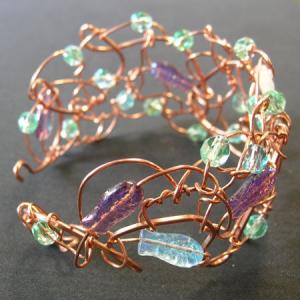Why “Wire wrapping” is a Traditional Metalsmithing Technique
What, exactly, are “traditional metalsmithing techniques”?
I’ve tried to figure it out because I see this phrase all over the place. So far, the only thing I’ve managed to determine is that it’s a blanket term for an assumed, but ill-defined, set of construction methods a skilled metalworker must know how to use.
A couple of months ago I opened up an Artfire Shop. Like “street teams” on Etsy, Artfire encourages craftspeople to band together and form “guilds” according to their specialties. I applied to join a Metalsmiths Guild, and was rejected. The reason given: “All members must have metalsmithed pieces listed live in their Pro Studio, and those metalsmithed pieces must make the majority of the items listed in their Studio, because our focus here is Metalsmithing. Your studio is basically filled with beautiful wire wrapped pieces at this time.”
When I went to look at the Guild Master’s shop, I discovered that about half of her available work was made of wire, much of it cold-worked. The difference? She was hammering it, as well as wrapping it.
There were several pieces of wirework on the Guild’s gallery page, and when I pointed this out to her, I got an indignant reply: “…there is not a single wire wrapped piece displayed in the [Guild] photo gallery. Not one piece. (except for one of my copper Hearts which has a few soldered components, as well as a wire ”stitching” detail around the heart, but that is not what we”d call ”wire wrapping” per say)”
She went on: “So, I”m really not sure where you saw this when you say “I note that several of your members have wireworked pieces included in the guild gallery.” – you were not looking at the [Guild] gallery. I can guarantee you that.”
I didn’t say wire wrapped, I said wireworked, and there were definitely several pieces in the Guild’s gallery. Once again, I was being slapped with dismissive terminology.
She sounded positively offended at the insinuation that any cold-joined wire jewellery might be included. “For the [Guild], we ask that our members focus on pieces geared towards ”traditional” metalsmithing techniques… ”
In the first essay of this series, I established that there are three major forms of metalworking: sheet, cast and wire. As the exchange with my ArtFire correspondent shows, there are divergent opinions about what construction methods are needed in order to actually call oneself a metalsmith. So, let’s start with a definition:
Met-al-smith, noun
∙ an artist or craftsman who works with metal, esp. in making sculptures, jewelry, etc. [1. YourDictionary.com/metalsmith]
∙ a person skilled in metalworking [2. Merriam Webster]
Let’s also clarify what “traditional” means:
Traditional, adjective
1. based on customs usually handed down from a previous generation <a traditional Passover meal at his grandparents’ house>
2. tending to favor established ideas, conditions, or institutions <a family that is very traditional when it comes to institutions like marriage>[3. Merriam Webster]
Wire jewellery – and in particular cold-joined wire jewellery – has a very long history, as evidenced by pieces in the collection of the British Museum, here, here, here, here, here and here and in the Victoria & Albert Museum here, here, here and here. In fact, this brooch dating from the Middle Bronze Age is among the oldest known pieces of classical cold-working.
Doing a search online for “wire wrapping” brings up all kinds of references to electrical equipment. I was surprised to find only one definition of “wire wrap jewellery”:
Wire wrap jewellery is a type of design and method of hand jewellery fabrication. [4. WordIQ.com] (emphasis mine)
Hand fabricated jewellery is built from constructed and assembled pieces, which have been soldered or cold-joined. It can use sheet, wire, found objects, you name it. Hand fabricated wire jewellery can incorporate a wide variety of different cold-joining methods such as weaving, coiling, seizing, stitching and lashing.
The single element which determines whether a piece of cold-joined wire jewellery is called “wire wrapping” is the presence of binding.
Tim McCreight lists wire “wrapping” second after “tabs” in Chapter 5 “Joining” of The Complete Metalsmith. He writes: “It’s hard to get much simpler than binding elements together with wire. Countless examples can be found in farm tools, kitchen utensils and ethnic jewelry from around the world.” [4. McCreight, Tim. The Complete Metalsmith, (Portland: Brynmorgan Press Inc., 2004), ISBN 1-929565-05-4, pg. 102] (emphasis mine)
In fact, he refers to “wire wrapping” as “The Original Cold Connection”. [5. McCreight, Tim. The Complete Metalsmith, (Portland: Brynmorgan Press Inc., 2004), ISBN 1-929565-05-4, pg. 221]
In other words, it’s a traditional metalsmithing technique.
<Previous Please Don’t Call Me a “Wirewrapper”




I was sorry to hear that someone of your skill and experience would be dismissed in any way that is derisive. I wonder if Arline Fisch could have applied and gotten accepted with a shop full of her cold joined works:)
The museum links were fantastic!! Thanks so much for them!
This is such a wonderful article you’ve written. I am very happy to have stumbled on to your blog..
Awesome article! To think that a metal working technique as “Wire Wrapping” could be dismissed as easily as that is a shame. I have had a few people tell me they only buy “real” jewelry and that does not include handmade artisan jewelry. What do they think people used before soldering techniques were discovered for use in delicate jewelry designs?
This is such an unappreciated artform. Even my metalsmithing instructor asked me to teach in her studio because she could not grasp the delicate technique of wire sculpture 🙂
I think this is a great article that really helps distinguish the many facets of wire smithing, which I think deserves its own category in metal smithing. Because it is often the easiest entry point for folks wanting to learn how to make wire jewelry, it needn’t and shouldn’t be dismissed because wire wrapping has so much exposure. Try and ignore folks like this who need to elevate themselves by making such stupid distinctions.
Hi Lisa! I agree that wireworking (“wire smithing” :)) is an excellent introduction to the world of working in metal. I’ll actually be covering that in a future essay. Thank you for adding to this discussion!
Actually depends on what you define as “wirework”. Reuther-style square wrapped wirework certainly isn’t traditional before the 1750s. There are 3 works in similar round wire styles that have been found in Medieval contexts, all appear to be small rings put together quickly, possibly for children. The whole impetus behind Reuther-style modern wirewrapping was the lack of specialized tooling and skills needed to complete each work, read early and even recent wire-work marketing sources if you don’t believe me. And that’s still the reason it’s so popular to do it.
McCreight’s first book was an introduction to many different techniques, generally covering each one in a page or two, and intended as a bridge between total beginners and more serious work. Try finding references to wire-wrapping in “Professional Goldsmithing” or ‘the Brehpol’, wire-SMITHING is indeed traditional, wire-wrapping isn’t.
The number of people claiming to be “jewelers” who can’t set gems, forge, file, solder or even use a saw is why most of us traditional metalsmiths tend to take very simple wirework less seriously.
Assembling pre made beads does not make you a jeweler, neither does wrapping a pre-tumbled agate into a pendant. There’s over 5000 years of traditional techniques in the jeweler’s art, it would be nice if people actually used more than one of them. Wire work can be lovely when done as part of something more advanced, but less so when done in a cookbook fashion because you don’t know how to do anything else.
Note that I don’t know your work and am not commenting on it, my comments are in general.
Grim, who does work in wire, plate, sheet, and gems but does not do wirewrap. I’ve been mastering the skills above plus casting, raising, enamels, repousee, etching, hand engraving, plating, and making the majority of made own tools for the last 30 years, and do think I’m a jeweler because of that.
And BTW, the “invention of soldering” is pre-2000 BC, look at early Celtic, Scythian and Etruscan works, some of the granulated spheres were 1/100 of an inch, which seems pretty ‘delicate’ to me.
Hi Grim –
Thank you for contributing your thoughts to this thread! I enjoy applying the skills I learned in sheet metal work, gem setting and other metalwork to my wirework. I agree that the onus is on the individual artist to develop and push their skills, even if, like me, they choose to stay with wire as their primary metal shape. I’d be interested in the references you mentioned for the 18th C. square wirework and Medieval contexts. Would you be willing to share them?